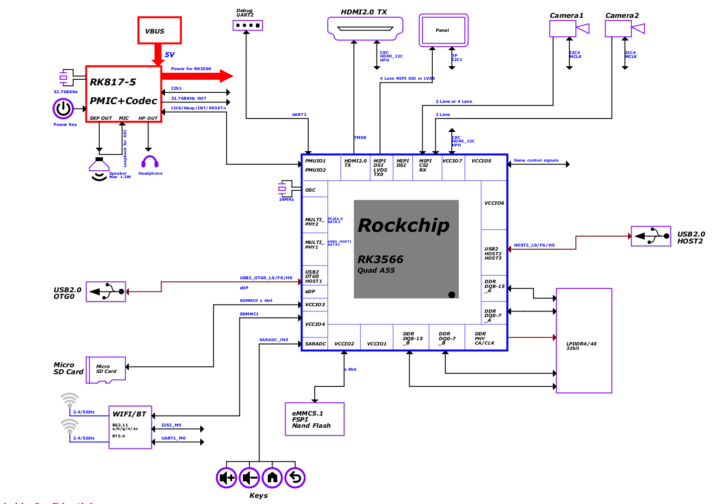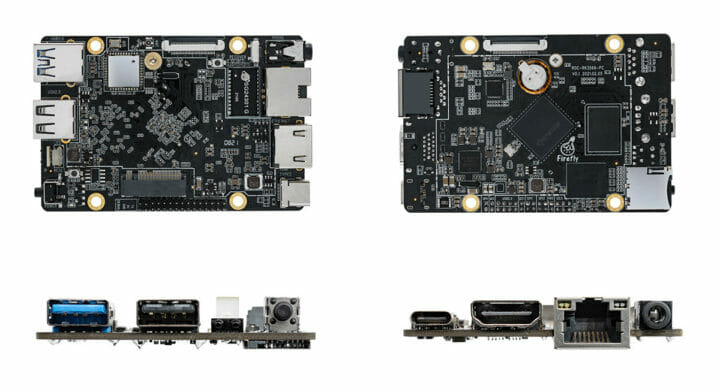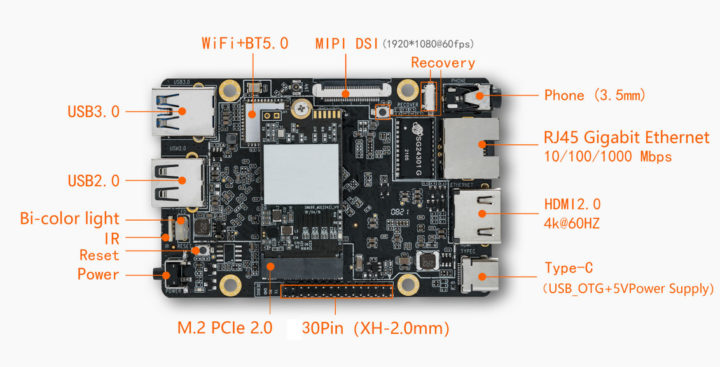Firefly has now launched a Rockchip RK3566 single board computer named ROC-RK3566-PC, following the launch of Station P2 RK3568 mini PC on Indiegogo last March, and the completion of the campaign a few days ago.
The quad-core Cortex-A55 SBC supports up to 8GB ECC memory, up to 128GB flash, M.2 2242 MVMe SSD’s, HDMI 2.0 and MIPI DSI video interfaces, Gigabit Ethernet, and more.
- SoC – RockChip RK3566 quad-core Cortex-A55 @ up to 1.8GHz with Arm Mali-G52 2EE GPU with support for OpenGL ES 1.1/2.0/3.2. OpenCL 2.0. Vulkan 1.1, 0.8 TOPS NPU, 4Kp60 H.265/H.264/VP9 video decoder
- System Memory – 2GB, 4GB, or 8GB LPDDR4 RAM with support for “all-data-link ECC” (TBC: Because the info I have so far is that ECC is supported on RK3568, not on RK3566)
- Storage
- 32GB, 64GB, or 128GB eMMC flash
- M.2 PCIe 2.0 socket for M.2 2242 NVMe SSD
- MicroSD card slot
- Video Output
- 1x HDMI 2.0 up to 4Kp60
- 1x MIPI DSI up to 1080p60 output, or dual-channel MIPI DSI up to 2560x 1440 @ 60fps
- Audio – 3.5mm earphone jack, digital audio via HDMI
- Camera – MIPI-CSI camera interface for up to 8MP camera sensor
- Connectivity
- Gigabit Ethernet low-profile RJ45 connector
- Dual-band WiFi 5 (802.11 a/b/g/n/ac) and Bluetooth 5.0
- USB – 1x USB 3.0 port, 1x USB 2.0 port, 1xUSB Type C OTG port also used for power
- Expansion – 30-pin IO header with I2C, SPI, UART, ADC, PWM, GPIO, I2S, etc. Note: 2.0mm pitch
- Misc – IR receiver, recovery, reset & power keys, dual-color LED
- Power Supply – 5V via USB Type-C port
- Dimensions – 90.0 mm × 60.0 mm
- Temperature Range – Operating: -10°C to 60°C; Storage: -20°C to 70°C
- Humidity -10% to 80%

The company will eventually provide support for Android 11, Ubuntu 18.04?, Buildroot + QT, Station OS, but right now only the Android 11 image and source code, plus the flashing tools for Windows/Linux are available on the Download page, where you’ll also find the schematics and datasheet for the board. Firefly has not linked to it yet, but the board should also support the RKNN Toolkit to enable Caffe/TensorFlow/TFLite/ONNX/PyTorch/Keras/Darknet support using the integrated NPU.

The low-profile Ethernet port is nice for people wanting to design compact clusters, and it’s not found in that many boards, with the only ones I can remember on the top of my head being the Khadas VIM3/VIM3L and earlier VIM boards. The presence of an M.2 slot for NVMe SSD may make it competitive against the Raspberry Pi 4 SBC since the latter could only support USB drives, or through RPI CM4 plus a carrier board.
Two versions of ROC-RK3566-PC SBC are currently sold in limited quantities with the 2GB RAM/32GB storage model going for $75 and the 4GB/32GB variant for $105. Those are promotional prices for the next 30 days, after which the boards will sell for $89 and $119 respectively. The model with 8GB RAM should only come a bit later. If you’d like an affordable single board computer with ECC memory, you may have to wait for ROC-RK3568-PC that is not up for sale just yet.

Jean-Luc started CNX Software in 2010 as a part-time endeavor, before quitting his job as a software engineering manager, and starting to write daily news, and reviews full time later in 2011.
Support CNX Software! Donate via cryptocurrencies, become a Patron on Patreon, or purchase goods on Amazon or Aliexpress






It’s very tempting. The low-profile ports disposition is good for small carry-everywhere stations, and the A55 + M2 makes it way more interesting than the RK3328 in their Station M1. But I’d only buy this with an enclosure. It looks like it should fit into the same enclosure as Station M1 but I didn’t find it for sale separately. At this size it also allows to build small distributed network storage nodes.
Let’s just wait for the enclosure then.
I would understand the excitement about the M.2 slot only if PCIe and SATA are multiplexed here since the amount of different 2242 NVMe SSD models can be counted with a single hand.
Looking at that shot of the underside of the board am I right in saying you could fit a longer M.2 drive so long as the 2242 screw doesn’t foul? You’d then have an SSD jutting over the side and need something to screw into but both of those could be solved with a custom case.
Sure that’s possible. But even then it would be desirable to be able to switch between PCIe and SATA not only since SATA should result in slightly faster sequential transfer rates than RK3566’s PCIe implementation.
Well, I had found this one which exists in 0.5/1/2 TB but I agree that in this form factor there aren’t that many: https://amzn.to/3uTRqG9
There’s also WD/SanDisk “PC SN520” (SDAPMUW), Transcend MTE452T, Lexar NM520 and the usual KingSpec/Netac crap that gets sold under various names.
Nice board! Have max 8GB, ECC Mem, and m.2 nvme. And with low profile design, we can design tablet/laptop using this. A pity price is bumped because nowadays MFs conditions.
Like @Willy said, it best when having a case. I won’t buy SBC that have no case. Too risky for my use case. Plus my area’s quite dusty..
> ECC Mem
Better read Jean-Luc’s remarks about availability of the (inline) ECC feature on RK3566/RK3568.
What’s sad with this situation regarding inline ECC is that it would cost much less operations to just append ECC data as an extra data transfer at the end of every exchanged cache line. It could even cost less extra RAM by being designed to perform single-bit correction per 64-byte (i.e. 1/512 bit fixable, 1/256 detectable). It would still mean that transfers between the cache and the CPU ALU couldn’t start before the cache line xfer is complete but that’s often the case with random accesses anyway. And it could be possible to transfer from L3 to L2 and to L1 in parallel and only validate/invalidate the transfer at the end when checking the ECC.
Thanks for the reading, Thomas. Still, wishing the applied ECC cost less and have low overhead. My knowledge about ECC is limited.
interestingly, this, inspired to question how often bit errors occur and real numbers on search engine server farms showed a 14 – 40 hours probability for one bit flip per 1GB of DRAM (higher probability with intense cpu utilization) from this source https://www.intelligentmemory.com/support/faq/ecc-dram/how-often-do-ecc-correctable-single-bit-errors-occur-and-how-about-double-multi-bit-errors.php ( might relate to a ~2009 study on DDR1-DDR3, summary https://arch.cs.utah.edu/arch-rd-club/dram-errors.pdf ) While this might be interesting for bit error recovery ( https://arxiv.org/pdf/2009.07985.pdf ) i did not found statistics for >(LP)DDR3 yet.
another number for LPDDR3 (~2015/2016) summarizes a ~0.2TBh (terabyte hours) error rate on ARM multi node memory supercomputing prototype without ECC ( https://upcommons.upc.edu/bitstream/handle/2117/96529/Unprotected%20Computing.pdf )
for the fun ( https://my.matterport.com/show/?m=oj5FSKsTt7o highlights, picture 7 from start )
You know the board is well designed/balanced, when the the 3.5 Jack and Power button look big. (no wonder phones drop it).
Only missing 1 usable USB Type-C (not for charging).
Curious who uses the CSI/Cameras on these SBCs ?
Now that ARM SoC’s jumped over the 4 GB RAM, I wonder of fitting 2 SO-DIMM slots on the bottom. Or invent new like the socketed eMMC slot on Friendlyarm/Friendlyelec/Hardkernel/Pine64/Olimex boards.
@Tom Cubie
I agree, these more powerful SBCs better get with it on the USB-C side of things. However, I have seen a Pi 4 used as a peripheral, (headless obviously), by connecting it to an iPad with a USB cable. Not sure if it was legit, because looking back on it that does seem kind of strange.
I have seen plenty of camera applications for SBCs, though it doesn’t really appeal to me personally. People also tend toward smaller, less capable boards when making camera projects.
> I have seen a Pi 4 used as a peripheral, (headless obviously)
You might refer to this guy carrying around an RPi 4 as ‘network connected’ Linux server for coding and storage? https://youtu.be/IR6sDcKo3V8?t=409
Technically there’s nothing special WRT USB-C here since USB gadget functionality exists in Linux since ages and this worked the same way also with SBC that can be powered via Micro USB and have USB OTG on the same port (BTDT with a NanoPi NEO as a Mac accessory almost half a decade ago).
Yeah, that’s it. I just wasn’t sure if RPi had a USB ‘device’ capability because I’ve never used it that way before.
SO-DIMMs use 64-bit memory, arm SoCs generally use 16 or 32-bit, so that’s still a no go in most cases or you need special SO-DIMMs.
Thanks I didn’t know. As pointed by @ tkaiser before MACCHIATObin (Marvell ARMADA 8040 SoC) has a full DIMM slot. Quick search shows there are (some) 32-bit SO-DIMMs.
As explained by Hardkernel’s Justin: if the SoC’s memory controller lacks DIMM support there’s no way to use DIMMs 🙂
And SoCs for TV boxes, phones and tablets usually miss this feature while SoCs that target other markets / use cases allow for either soldered or socketed RAM.
ROCK3 is in schedule, everything you want for a low cost ARM SBC.
Thanks. Good luck!
One more thing. Why the M.2 isn’t put the other way to fit both 2242 and 2260?
Care to give us a hint about the specs? 🙂
Any update for RK3588 ???
### depending on Your preferencies and usage patterns, most interesting sbc socs are from Mediatek and Rockchip concerning desktop/laptop performance replacement and npu inclusion. Innovation towards top functionality (cpu speeds ~4.5Ghz(-<5Ghz), memory, integrated graphics, interfaces (USB4) ) is towards Zen4/Zen5 (x64 starting big.LITTLE), Alder Lake, stacked 3d nand flash for this/coming years (>q3 2021-2022). Sbc’s will get concurrency on low power idling usage profiles, but also evolving towards improved interfaces (pci-e towards 3.x) on the other side.
Different situation on server side and mobile data processing units and peripherals.
> Sbc’s will get concurrency on low power idling usage profiles
SBCs are already beaten since half a year. A MacBook Air with M1 SoC idles significantly below 1W with screen powered off. Sure, this ‘use case’ looks rather dumb today but I would believe a lot of those early M1 devices will serve headless in 5-7 years with *BSD or Linux.
impressive, but that’s on ~$900 budget (2020), that SBCs with Rockchip and MediaTek SoCs (maybe even mid-class mobiles on Linux would compare) will most probably deceed by far. For x64 devices there’s some software advantage (at least until there is no “recognizable” overprovision on memory and multi-core abilities for instruction set translation (or emulation getting to ~90% efficiency nowadays compared to most common native platforms, AFAIK) for demanding tasks for video editing, industrial simulation work or design work, for example. At least for some years, I still would expect this being an adavantage. No experience on Rosetta 2. )
The RK3566 doesn’t seem to be any better than the S905X3, which has been around for a good while now and at the price charged, I don’t think that this will be a very long lived SOC or it will have to be very heavily discounted or have very broad real world open source buy in from Rockchip to even try to compete.
Not even a remote consideration for me right now.
It depends on the application. The CPU and video capabilities are about the same as S905X3, so for instance, there’s little to no benefit for TV boxes. But the GPU may be faster, and the most important parts are the SATA 3.0/PCIe interfaces on RK3566/RK3568 which are missing on S905X3 since it’s a TV box SoC.
People forget the Amlogic S908X is due, just the crazy high prices and chip parts shortages effecting things world over.
RK3566 or a S922X ?
Well i didn’t completely forget about this weirdly named S908X (looks like a regression from S922X while it should be an improvement)…
it’s just that i don’t have much expectation from amlogic in terms of IOs… hopefully this time they won’t mux usb3 & pcie
RK3566 & S922X don’t target the same applications : the formet has better IOs while the latter has much more processing power
RK3566 or S922X is going to be which is better for individual use cases.
the RK has only a 2-core GPU and the AML is a 6-core GPU (both are Mali-G52), say for a Retro Game Emulation machine or handheld, which will be better? Whatever software can take full advantage of the chips full GPU capabilities. RK3566 doesn’t improve enough IMO to replace the RK3399 or S922X in any use case. In certain use cases the RK3568 is different enough (I/O) to replace Rpi4 and other mid-tier platforms though, and I like the layout of Firefly’s Station_P2 machine with its metal case, hopefully Radxa and FriendlyELEC will be releasing a half-dozen boards with the RK3568 for multiple use cases as well.
> RK3566 doesn’t improve enough IMO to replace the RK3399 or S922X in any use case
Use cases that may benefit from up to 8GB RAM, e-Ink or 2 times native SATA might disagree once RK3566 devices get cheap 😉
Also I’m curious about idle consumption of future RK356x devices…